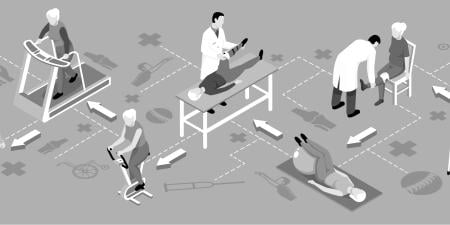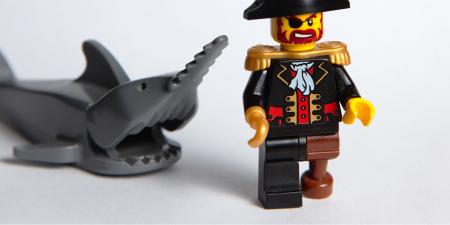Bashert: a Yiddish Word Meaning Preordained or Meant To Be
Martin Kohn (MK): My entry into the field of medical humanities at Northeast Ohio Medical University (NEOMED) in 1981 places me in the second generation of those to enter a field whose roots go back to 1960 [1]. Although not part of the initial wave of immigrants to the shores of this new multi- (or for some, trans-) disciplinary academic endeavor, the second wave was still a time when many of us from disparate fields—my training is in education—received a warm welcome. I began my work at NEOMED a few months after its inaugural class graduated. How unexpected, then—and fortunate—to find myself in exactly the same situation 28 years later (in 2009) at Cleveland Clinic Lerner College of Medicine (CCLCM) of Case Western Reserve University. Was it fate? Destiny? Or was it what we might call bashert that my department chair would be a former (favorite) NEOMED student—and friend—Rick Kodish.
Eric Kodish (EK): And if I were firmly in the medical humanities, I would be in the third wave. Starting medical school in 1982, I knew that the art of medicine interested me more than the science. Finishing my pediatrics residency and heading for a career in childhood cancer in 1989, I was told by a very prominent leader that I would never succeed unless I did hard science, that is, bench research. I responded by taking an ethics fellowship to complement my oncology training and began 20 years of research on informed consent and pediatric research ethics. Is ethics a subspecialty of the medical humanities? To this day I am not sure. But I do know that hiring Marty Kohn to lead our Cleveland Clinic Program in Medical Humanities feels like it was bashert.
Curricular Challenges
MK: The nascent NEOMED curriculum I inherited was offered exclusively in the senior year. It was a required course that was tailored to each student through elective offerings in the humanities and the behavioral and social sciences that each student chose to engage. Our task was to move the work to the earlier years of the curriculum as well, creating full curricular integration. The task at CCLCM was different. Since its inception, the school has required medical humanities coursework throughout its five-year curriculum (including a research year). The challenge I faced was to reshape the 108 dedicated classroom hours that occurred during the first two years of the curriculum to provide a stronger foundation both for later work in the curriculum (30 hours in year 3 and approximately 10 hours each in years 4 and 5) and for our students’ graduate medical education and years of medical practice. Our team—child and adolescent psychiatrist Molly Wimbiscus, MD; performing artist and arts educator Katherine Burke, MFA; and I—has worked with a group of seasoned physician small-group discussion facilitators, thematic “block leaders,” and guest presenters to fashion a two-year foundational medical humanities program that operates out of a “big tent” curricular framework. We have coursework in both years in traditional humanities disciplines (primarily literature and history), bioethics (primarily clinical), and health care systems (from comparative, practical, policy, and justice perspectives). We’ve also developed a community-based, longitudinal arts and neighborhood health and well-being experience during the first year—Devising Healthy Communities—that includes a dollop of qualitative research fundamentals. We have reflective writing sessions throughout both years, capping each of our three first-year writing assignments with the presentation of dramatic vignettes based on a creative amalgamation of the students’ writing and performed by professional actors. This “meta-reflective” activity has been rated very highly by our students. With student assessment for all coursework at CCLCM exclusively based on electronic portfolios, we have developed over the past few years a number of opportunities for students to submit assignments in addition to their reflective writing for critical comments by faculty in a number of our teaching blocks. Most recently, we implemented a bioethics case write-up exercise that calls upon numerous bioethics staff members as well as fellows in our Cleveland Fellowship in Advanced Bioethics program to offer their critical insights to our students. Having rich resources and the willingness of so many staff members to participate in our programs makes our work significantly stronger and, according to students, increasingly valued.
EK: As director of our Center for Ethics, Humanities and Spiritual Care, I am responsible for setting its vision. Vision setting works best as a collaborative project, and education serves as the unifying theme. Some of our faculty are more clinically oriented, while others are primarily engaged in research. Education brings everyone together, and Marty’s leadership in creative approaches is universally respected. A number of other respected leaders within the clinic have come together to support the humanities vision. Most importantly, CCLCM’s executive dean, James Young, MD, has been an enthusiastic partner in our medical humanities work.
Collaborations
MK: Perhaps because of its very nature as a consortium, NEOMED offered opportunities for collaboration. The vehicle for my initial collaborative efforts there sprang up from the William Carlos Williams poetry competition for medical students, which I established at the end of my first year [2]. The poetry competition played a central role in the building of other collaborations, including the Center for Literature and Medicine (now housed at Hiram College) and a literature and medicine book series published by Kent State University Press. My outreach efforts at CCLCM are built on my previous work at NEOMED and Hiram College—for example, co-producing with our local NPR affiliate, WCPN-FM, a radio drama of the play Wings—and on new collaborations with the Cleveland Institute of Art (developing an elective, Portrait Drawing, Visual Thinking Strategies, and Increased Observational Skills), and John Carroll University (whose arts and sciences faculty members staff our medical humanities teaching blocks). Another deep collaboration among our students, four Cleveland neighborhoods, and local artists (visual, spoken word, and hip hop) is the Devising Healthy Communities project, which is entering its third year of development within the first year’s Community and Calling block.
EK: The Devising Healthy Communities project would not be possible without the generous support of the Cleveland Foundation. Our philanthropic partners are critical to our current and future success, and I am committed to helping our Program in Medical Humanities secure the resources it needs to teach the next generation of physicians. We must ensure that the miraculous but unflagging progress on the scientific and technical sides of health care is balanced by an emphasis on professionalism, virtue, and character. This commitment was perhaps best stated by Hans Jonas [3]:
Let us not forget that progress is an optional goal, not an unconditional commitment…. Let us also remember that a slower progress in the conquest of disease would not threaten society, grievous as it is to those who have to deplore that their particular disease be not conquered, but that society would indeed be threatened by the erosion of those moral values whose loss, possibly caused by too ruthless a pursuit of scientific progress, would make its most dazzling triumphs not worth having [4].
A Vision for the Future
MK: A spate of recently published articles theorize on the role of medical humanities in medical education [5-7]. These works add to decades of thinking about and justifying the presence of medical humanities in the curriculum. However, as Angela Woods notes, many in our field have an “indefatigable [penchant for] exploration of its identity, purpose and value” [8]. In the end, I think many of us who teach in this field simply hope to encourage (without moralizing), provoke (without propagandizing), critique (without sniping), and jest (without demeaning). Modeling and passing on these stances, however, depends greatly on a willingness to take the time to stay wide awake to others’ experiences and perspectives [9], something that many of us in the field strive mightily to imbue in our students and in ourselves. With a view toward further exploration of such process-oriented goals, we are planning to convene in Cleveland, in the spring of 2016, an International Summit in Medical Humanities and the Arts. A bit further down the road, in 2019, with the opening of a new Case Western Reserve University Health Education campus at the Cleveland Clinic, we aim to have intercampus programming (with arts and sciences faculty) as well as interinstitutional programming (with, for instance, the Cleveland Museum of Art, the Cleveland Museum of Natural History, and other University Circle educational institutions) that will be the early bloom of a regionwide health humanities, social medicine, and arts consortium flourishing in Northeast Ohio.
EK: Amen.
References
- Fox DM. Who we are: the political origins of the medical humanities. Theor Med. 1985;6(3):327-341.
- Kohn M. A reminiscence. J Med Humanit. 2005;26(4):273-276.
- Jonas H. Philosophical reflections on experimenting with human subjects. Daedalus. 1969;98(2):219-247.
-
Jonas, 245.
- Kumagai AK, Wear D. “Making strange”: a role for the humanities in medical education. Acad Med. 2014;89(7):973-977.
-
Boudreau JD, Fuks A. The humanities in medical education: ways of knowing, doing and being [published online ahead of print April 8, 2014]. J Med Humanit. doi:.
-
Metzl JM, Hansen H. Structural competency: theorizing a new medical engagement with stigma and inequality. Soc Sci Med.2014;103:126-133.
- Woods A. Review of: Bates V, Bleakley A, Goodman S, eds. Medicine, Health and the Arts: Approaches to the Medical Humanities. Med Humanit. 2014;40(2):146-148.
-
Greene M. Towards wide-awakeness: humanities in the lives of professionals. In: Wear D, Kohn M, Stocker S, eds. Literature and Medicine: A Claim for a Discipline: Proceedings of the Northeastern Ohio Universities College of Medicine’s Literature and Medicine Conference, May 1984. McLean, VA: Society for Health and Human Values; 1987:3-15.



